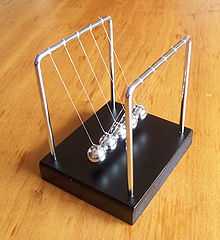Executive toy

Office toys are raised and developed gradually according to needs from office workers in the market. Unfortunately, most toy researches were focusing on the pleasure, mental or physical developments contribution in underage people, and lack of understandings on adult for playing toys in the working field. Nowadays, office toys have been treated as an important role in employer management in many companies. Office toys are playthings that could provide pleasure, relief stress and inspire creativity.[1] Office toys not only recalls the merry moments of playing toys in the early age, but also provides the function in decorating employer's personal working area and could lead office workers to relief stress by playing them. One of the classic office toy is Newton's cradle
History
An early executive toy may have been a gadget designed by the mathematician and engineer Philo of Byzantium (c. 280 BC – c. 220 BC), which was an octagon-shaped ink pot with openings on each side. One could turn the pot so that any face was on top and dip the pen in the opening, but the ink never ran out through the holes on other sides. The interior inkwell was suspended in the centre on a series of gimbals and remained upright in spite of any rotation.[2]
Ancient Chinese emperors and nobles often collected natural and man-made curios, such as multiple concentric carved ivory spheres, or chains carved from a single piece of jade.
The European cabinet of curiosities, or "Wunderkammer", often included devices that were ancestors of modern executive toys, including clockwork automata.
The Functions of Office Toys
Different types of office toys provide different needs to their users. Although providing pleasure and being decorative could be the two major functions in office toys, there are still some differences between each types of office toys. For example, Puzzle type of office toys provides the function inspiring creativity under the statement of playing them. Physical type of office toys provide the function of a short time concentration transit.[3]
Examples
- Ant farm
- Aquarium (fake or real)
- Baoding Balls
- Chaotic pendulum (for example, a double pendulum)
- Crookes radiometer
- Drinking bird
- EcoSphere (closed aquarium)
- Etch A Sketch
- Euler's Disk
- Ferrofluid toy
- Hoberman sphere
- Hourglass
- Lava lamp
- Liquid motion toy (Dripper or Wave Motion variants)
- Magic 8-Ball
- Magnetic face toy (Fuzzy Face, Wooly Willy, etc.)
- Mechanical bank
- Mechanical puzzle
- Musical box
- Nanoblock, a system of plastic building blocks similar to Lego but about half the linear dimensions. Most finished models are designed to be tiny, of a size suitable for an office desk decoration.
- Neodymium magnet toys
- Newton's cradle, where a set of metal balls are suspended from above, one is pulled from the rest and kicks them, transferring the kinetic energy to the last one.
- Novelty lighter
- Novelty magnet
- Paddle ball
- Paperweight
- Perpetual pendulum, which doesn't stop due to an electric magnet in the base of the toy.
- Perpetual spinning globe, actually powered by a small battery
- Perpetual spinning top, actually powered by a small battery
- Pin Art, a box with numerous small pins of equal length inserted into a board, that can be pressed from one side with any object so that the other ends of the pins form a three-dimensional image of the object on the other side of the board.
- Plasma globe
- Rubik's Cube
- Rubik's Snake
- Sand Pendulum
- Snow globe
- Stirling Engine (miniature, powered by warmth of a hand)
- Stress ball
- Superegg
- Top
- USB toys or USB decorations, small gadgets or toys which draw their electrical power from the Universal Serial Bus (USB) port on a computer or other device. Some can actually be controlled remotely from a computer or cellphone.
- Squirt gun
- Yo-yo
- Zen Garden
References
| ||||||||||||||||||||||||||||||